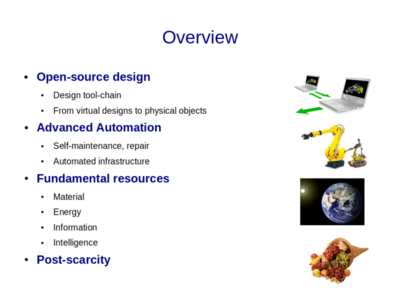Post Scarcity
Overview
Post scarcity (also styled post-scarcity or postscarcity) is a hypothetical form of economy or society, in which things such as goods, services and information are free, or practically free. This would be due to an abundance of fundamental resources (matter, energy and intelligence), in conjunction with sophisticated automated systems capable of converting raw materials into finished goods, allowing manufacturing to be as easy as duplicating software.
Post Scarcity Community
A post-scarcity community is a community that achieves low work-hour requirement for attaining a modern standard of living, while not participating in any geopolitical compromises whatsoever - as a route to freedom, meaning, and pursuit of happiness - both on the personal and political level. This type of community is marked by transcendence of artificial scarcity that is found in 'mainstream' economic paradigms.
Post Scarcity Production Levels
Artificial scarcity includes, among others:
- A Prussian-based education system to generate specialized factory workers as opposed to diversified independents
- Maintaining monopolies on resources and production
- Guiding human opinions towards particular consumer choices
- Necessity of warfare for securing material feedstocks
- Firm police state assistance in maintaining specified patterns of wealth distribution
- Overspecialization - specialized machines and humans
- Competitive waste, such as proprietary research
- Nonstandard components and hundreds of different products with limited coordination of production
- Dedicated components with little use outside of their specified function
- Non-customizable products
- Significant capitalization requirements for startup as a significant barrier fostering monopolization of production
- Banking procedures that favor support of non-innovative solutions
- Design for obsolescence, throw-away products, and throw-away society
The above combine to result in production and products that are inferior, short-lived, and inadequate for true human needs.
The remedies for the above, on a point-by-point basis, are:
- Self-education, online learning, internships, mentorships, or experiential learning
- Replacing scarce resources with ubiquitous resources, by refining one's tastes or by using enabling technologies that allows the transformation of ubiquitous resources into services formerly provided by scarce resources
- Elimination of advertising hype
- Peace-building by turning to local resources as a means of generating prosperity
- Wealth distribution is informed by stewardship over resources
- Generalization - multi-purpose machinery and multi-purpose people
- Collaboration for open product development
- Standardized components without reducing functionality, and scalable, modular components
- Generalized components which can be used in many applications
- Customizable, scalable, modular, multipurpose products
- Lowering barriers to entry via low-cost access to equipment and zero access barriers to enabling information
- Crowd funding, loans from family and friends, access to productive equipment instead of bank papers
- Lifetime design
The above elements of non-scarcity combine to what is known as abundance - which is a mindset enjoyed by only a small fraction (~1%) of the population. However, as people evolve their index of possibilities to include practical routes towards post-scarcity, as embodied in the GVCS, then the principles of abundance turn into practice.
Post-scarcity production is a level of production attained that is so easy and accessible that it loses its power of control of people over one another.
Details
- Scarcity-Based Business Models
- Subtleties of Scarcity Thinking
- Post Scarcity Presentation
- Digital Fabrication
